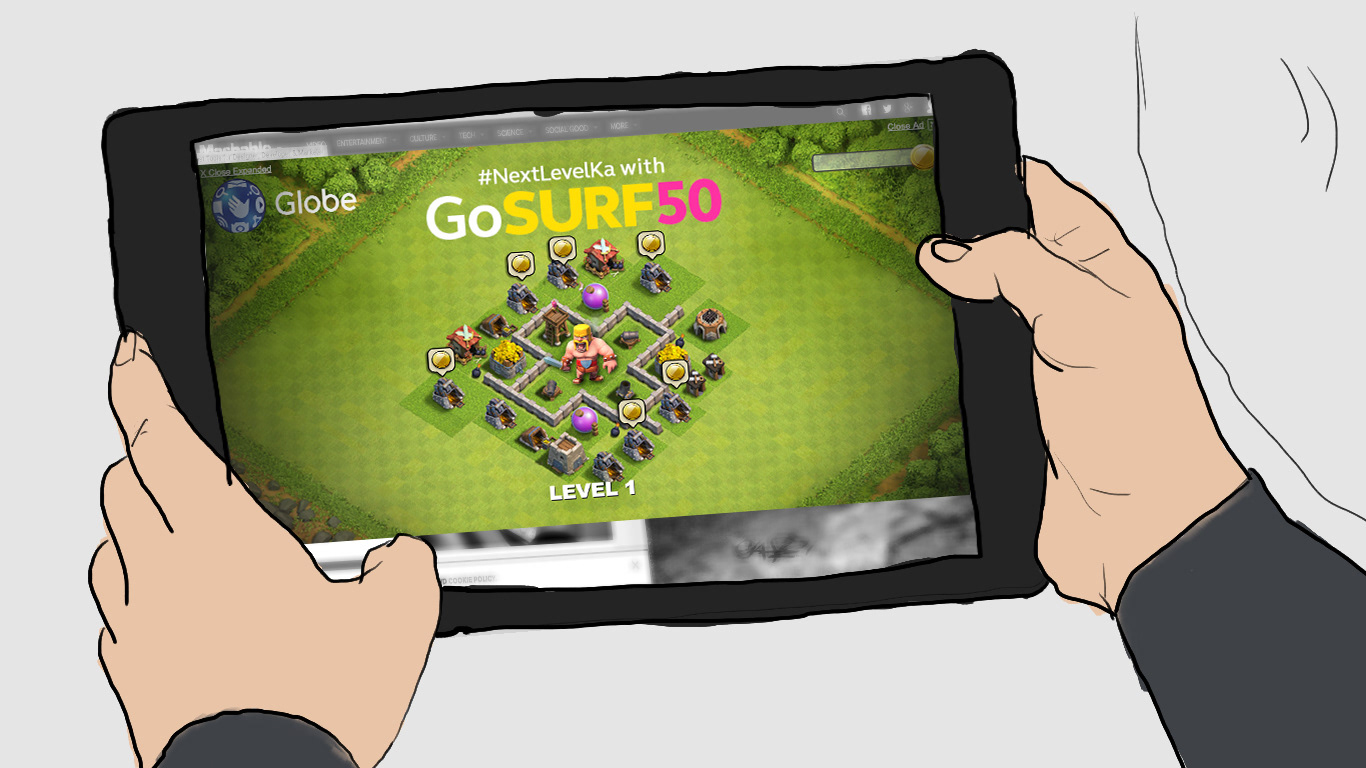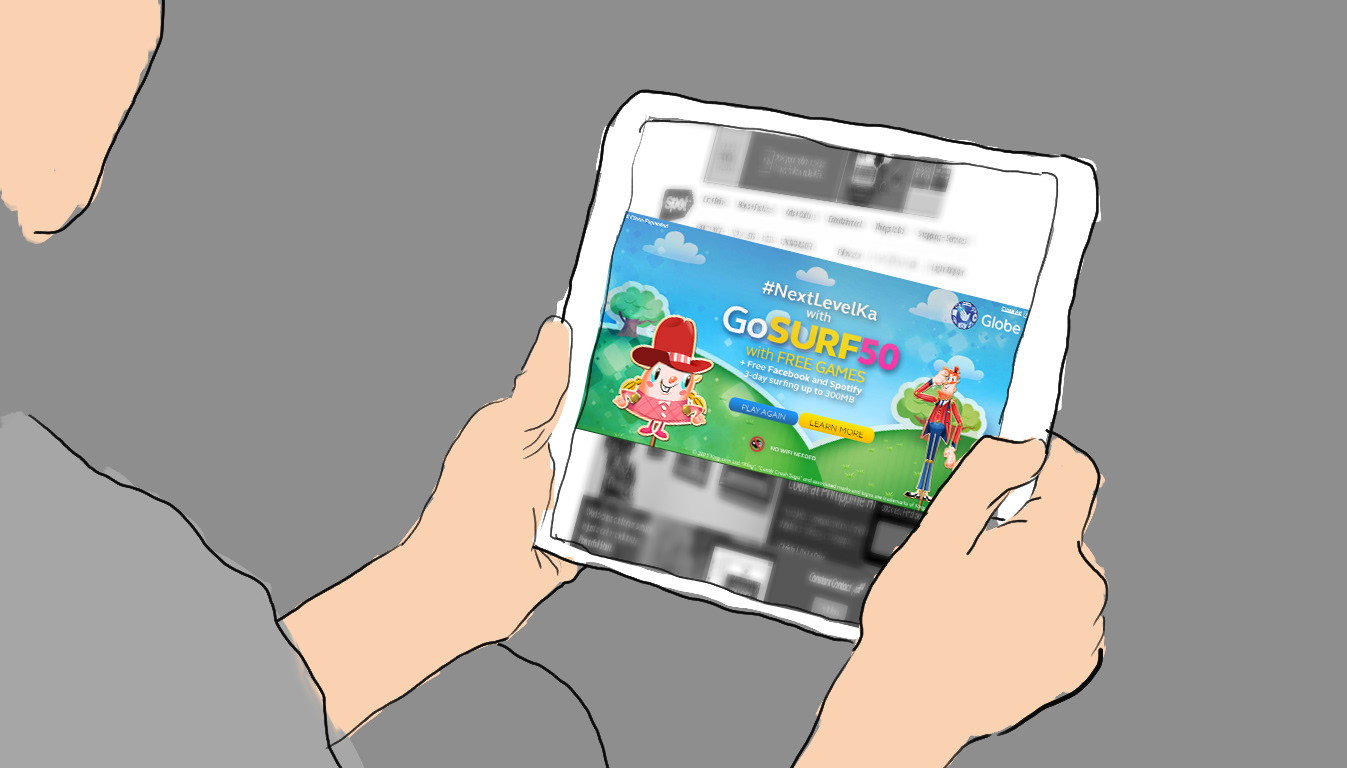This is a case study that primarily puts the coined terminology, "waterfall process" into the spotlight, and in the lens of a time-sensitive UX deliverable. A typically-frowned upon concept in the tech startup world, waterfall often creates problematic issues among product and UX teams. There are hundreds of books, and articles documenting that topic. For this project though, read on as to how we were able to pull off a huge digital campaign armed with that method and a team that was known to be among one of the most resilient in the agency.
The concept
This digital campaign was launched alongside a TVC to promote the telco giant's product, GoSurf50 using two clever usage of audience-driven strategies: easter egg hunting (using the TVC and SMS), and interactive gaming (digital). We worked alongside Google to publish an ad that housed a pop-up Clash of Clans, Candy Crush and Summoner's War games.


Gamifying an ad campaign in a highly traditional agency
As the sole interactive designer for this project, I worked alongside a Frontend developer in producing this ad. We started off by creating concepts (paper, whiteboards) and having a checklist of the technical deliverables - including those that deals with the internal team. After an idea gets a go-signal, we would then proceed to side-by-side design, and development using tools such as Adobe Illustrator, HTML5, advanced css and paper prototyping with the team. Once the interactivity is already functioning, it would then be handed off for QA (creative directors, art directors, project managers and account managers), and client approval. I think it is also worth noting that this process took place in a span of 3-5 days per game, including ideation and code production, excluding the publishing time (at that time, it took about as long as 24 hours for an interactive ad to get approved and published on Google Southeast Asia).


Measuring success with delight (and sales!)
Delight goes beyond the surface. For an interactive ad to work, especially with mouse-triggered pop-up ones, it is important to not just capture the audience in an instant, but for them to like you enough to stay...and play the game, way ahead of their presumed annoyance, and frustration.
So naturally, we made sure all the elements presented would act as components that were reusable, and lightweight to minimize loading time, thus setting the stage for a mindful user experience, regardless of how long the user actually intended on staying. We also made sure that the copy, and the overall messaging took up a fixed screen real estate, therefore placing our bets on both the gameplay, and the client exposure. A singular winning combination.
Defying the odds in the most unconventional of ways
When faced with time-sensitive projects like this, a solid collaboration and transparency is key. Pushing production-ready code, and UI can be tricky when you are doing it under an insane amount of pressure. Suddenly, your priorities as a Creative shifts: it's not just the consistency on the branding that you are most worried about, there are also the factors of usability (Is it actually playable? Will our intended users be able to access it? Will it work on every device? Is the gameplay compliance with Google best practices?), responsiveness, and purposeful (Will it hurt or help the campaign? Are we sending the right message to our audience? Is it truthful? Is it ethical?)
We aimed for an experience that provided intrinsic values to our targeted audience. Those were the values of joy, delight, mystery, adventure and a sense of belonging to the digital world. Admittedly, this wasn't the simplest of task to pursue, and to evangelize but it has definitely paid off:
A few months after release, this ad went on to win a Bronze award at the 2016 Tambuli Awards Asia ('Globe hidden codes'), and a few other award-giving bodies on Southeast Asia.
the key visual for this digital campaign
Look and feel 1 (published)
Look and feel 2 (unpublished)
Here's a copy of the proposed storyboard for the YouTube Masthead for this campaign:
In defense of the waterfall
Like what I've mentioned, waterfall is a typical software development process on advertising, and pr agencies that produces both traditional and digital marketing products. One simply can't avoid it, nor fix it in an instant. As a designer, I knew it was my duty to advocate for best practices, especially for the interactive medium. By being a part of the solution, instead of the contributor to the problem, I was able to make a small difference to the way the innovation team worked, and just like any digital product, every project is different, but the medium is consistently robust, and exciting, and thrilling but is significantly more complex than most, especially with the rise of AR/VR/Mixed Reality and other emerging technologies. Regardless if I was working on a waterfall or on an agile, I have to always be an advocate for better dev-design production through proper documentation, smarter handoffs and whatnot.
Credits to my hardworking team
I have worked with a team of creative directors (Paolo Toledo, Jeff Mendoza), art director (Raizel Go), and a Frontend developer (Daryl Lobren) for this campaign for Globe Telecom under Manila-based agency, Publicis JimenezBasic.
Sources:









